Water Security in the Syr Darya Basin
Abstract
:1. Introduction
2. Water Security
3. Water Security Approaches in the Syr Darya Basin
3.1. Geographic Background to the Syr Darya Basin
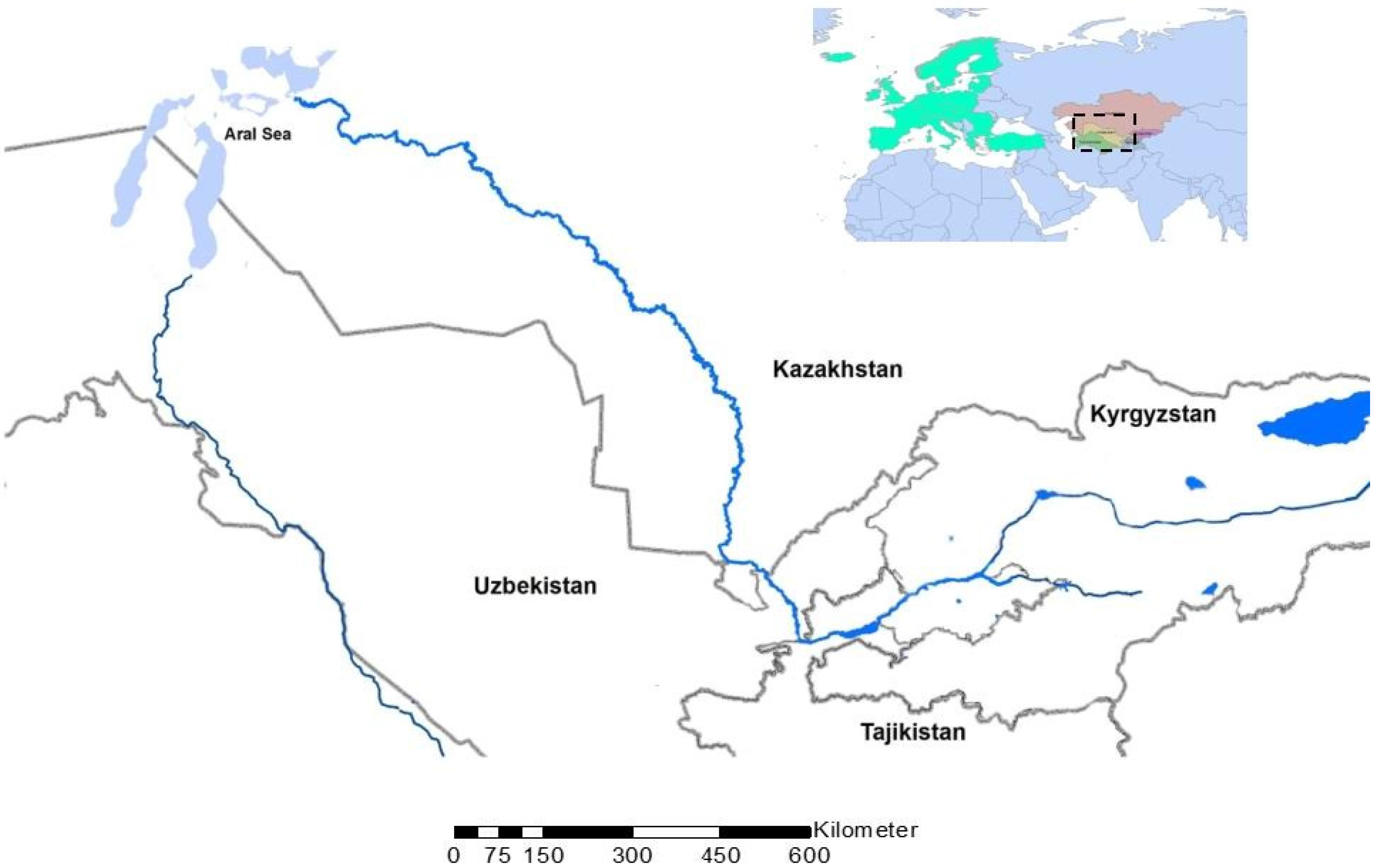
3.2. The Common Approach to Look at Water Insecurity within the Syr Darya Basin
3.3. Water Insecurity at the Meso-Level: Irrigation Districts and Within
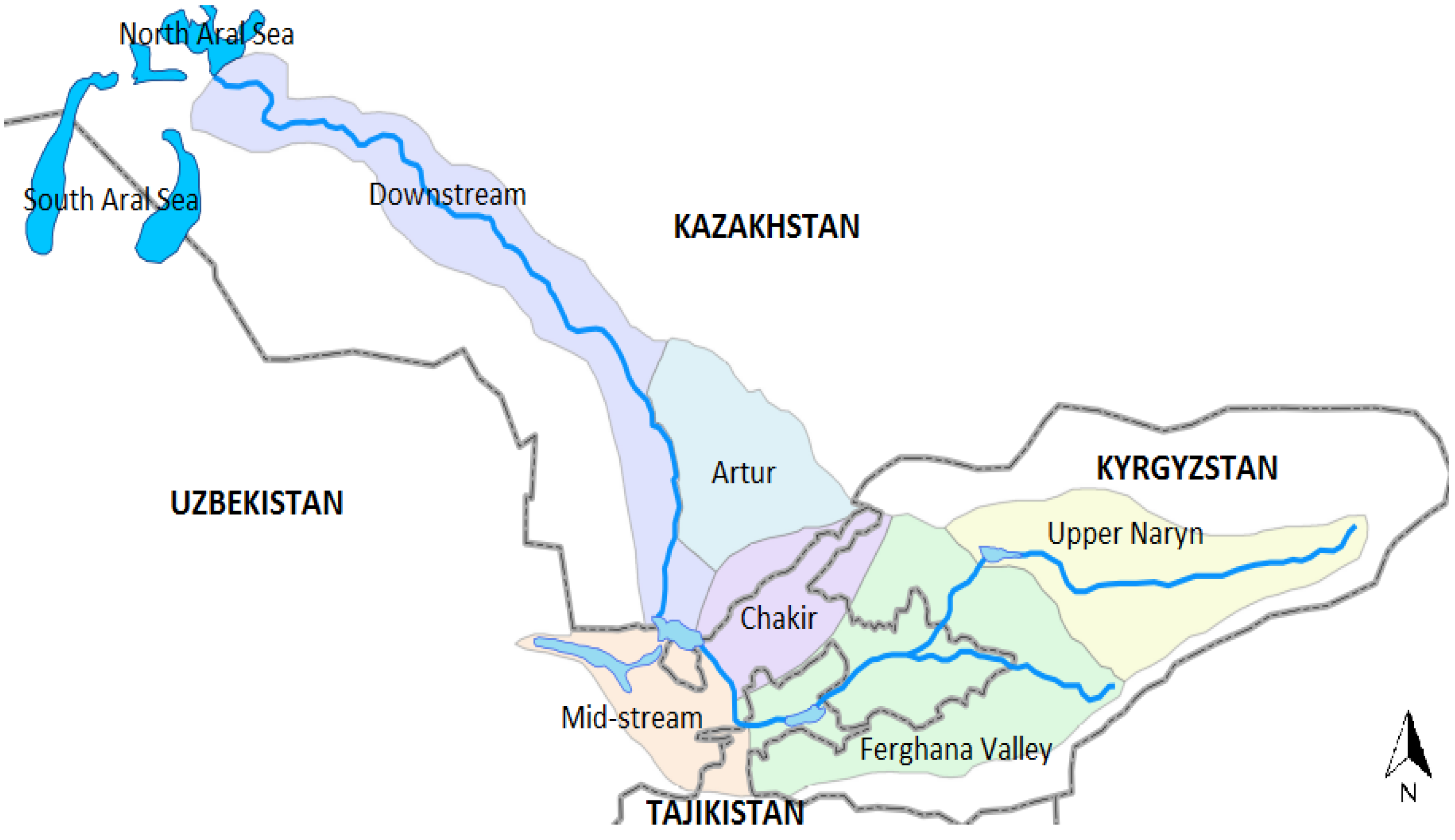
| Irrigation District | Source (km3) | Storage (km3) | Republic | Irrigated Land (1000 ha) | Total Water Use (km3/year) |
|---|---|---|---|---|---|
| Upper Naryn | Naryn (14.5) | – | Kyrgyz SSR | 130.3 | – |
| Ferghana Valley | Naryn (14.5) | Toktogul: Total Storage (TS)-19.4 Active Storage (AS)-14.0 | Uzbek SSR | 409.8 | 4.69 |
| Tajik SSR | 97.7 | 1.36 | |||
| Kyrgyz SSR | 22.5 | 0.74 | |||
| Karadarya (3.9); Small Transboundary Tributaries (STT) (total 7.8) | Andijan: TS-1.9; AS-1.8; Some smaller transboundary reservoirs | Uzbek SSR | 471.7 | 5.75 | |
| Kyrgyz SSR | 293.7 | 3.21 | |||
| Tajik SSR | 30.5 | 0.23 | |||
| Chakir | Chirchik (7.8); Akhangaran (0.7); Keles (0.3) | Charvak: TS-2.0; AS-1.6 | Uzbek SSR | 347.2 | 3.43 |
| Kyrgyz SSR | 9.5 | 0.04 | |||
| Kazakh SSR | 89 | 0.89 | |||
| Mid-stream | Main stem | Kayrakum: TS-4.0; AS-2.6 Farkhad TS-0.15 | Uzbek SSR | 629.7 | 7.19 |
| Tajik SSR | 87.6 | 1.03 | |||
| Kazakh SSR | 117 | 1.34 | |||
| Small Tributaries (0.3) | – | Uzbek SSR | 33.6 | 0.3 | |
| Tajik SSR | 30.5 | 0.23 | |||
| Artur | Arys (1.2) | – | Kazakh SSR | 200 | – |
| Downstream | Main stem | Chardara:TS-5.7; AS-4.7 | Kazakh SSR | 374 | – |
4. Past and Current Water Security Approaches: Capturing Winter Flow and Alternative Sources
4.1. Past Water Security Approaches–Example the Ferghana Valley Irrigation District
4.2. Current Water Security Approaches
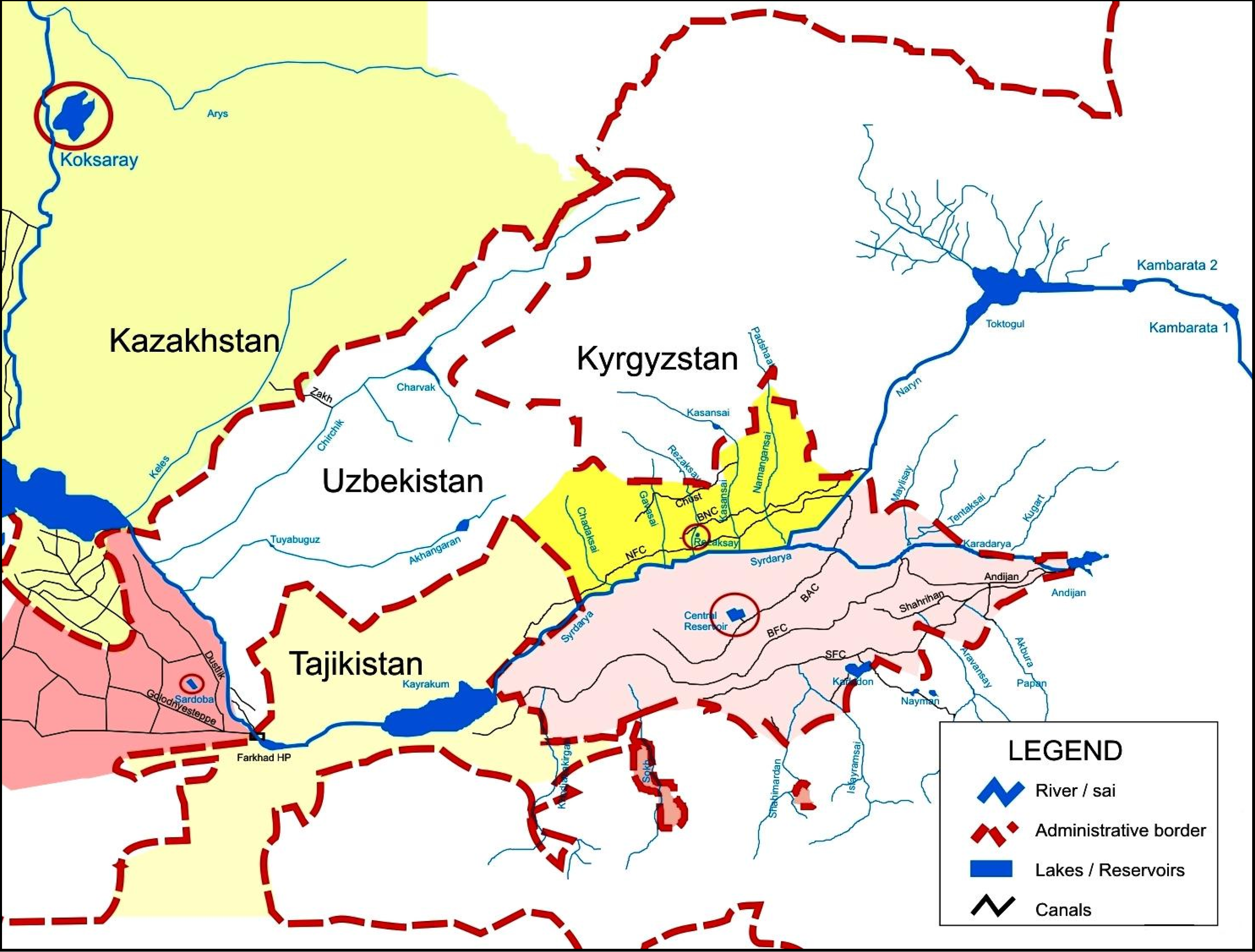
4.3. Short Discussion: Downstream Countries Increasing their Indirect Water Security
5. Surveillance and Guards–Irrigation Bureaucracy (Example Ferghana Province)
5.1. Geographic Background to Ferghana Province
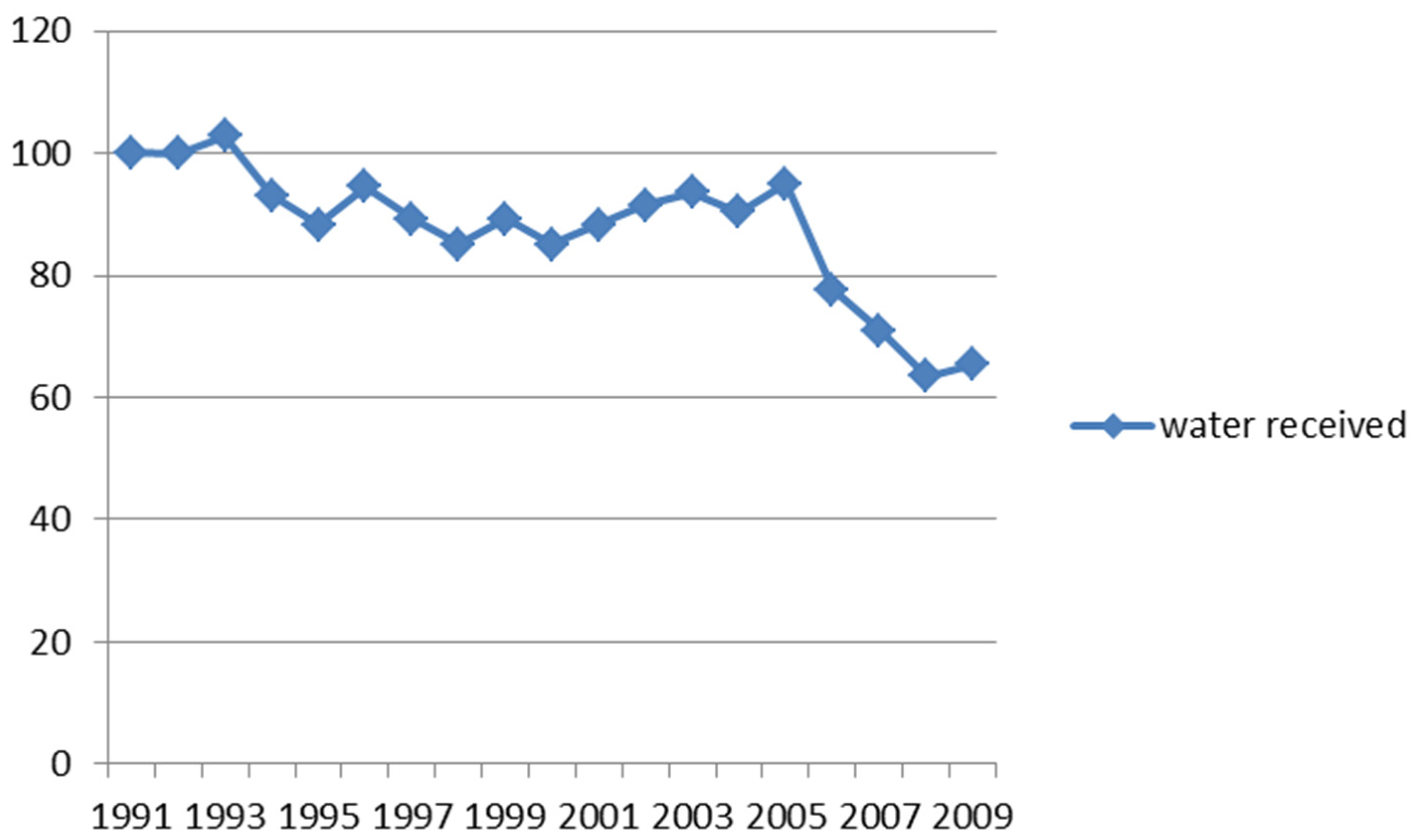
5.2. Demand Side Changes-Farming Units and Crops
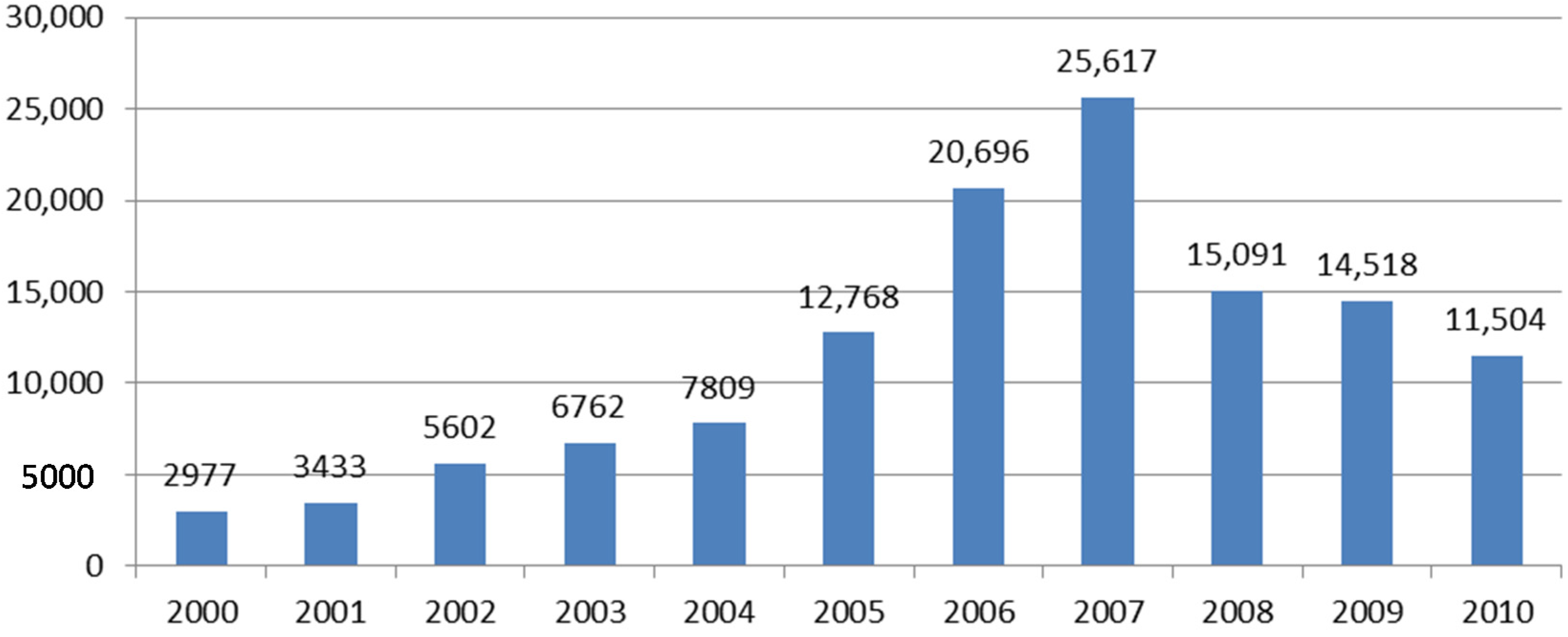
5.3. Current Water Security Approaches Focusing on the Demand Side
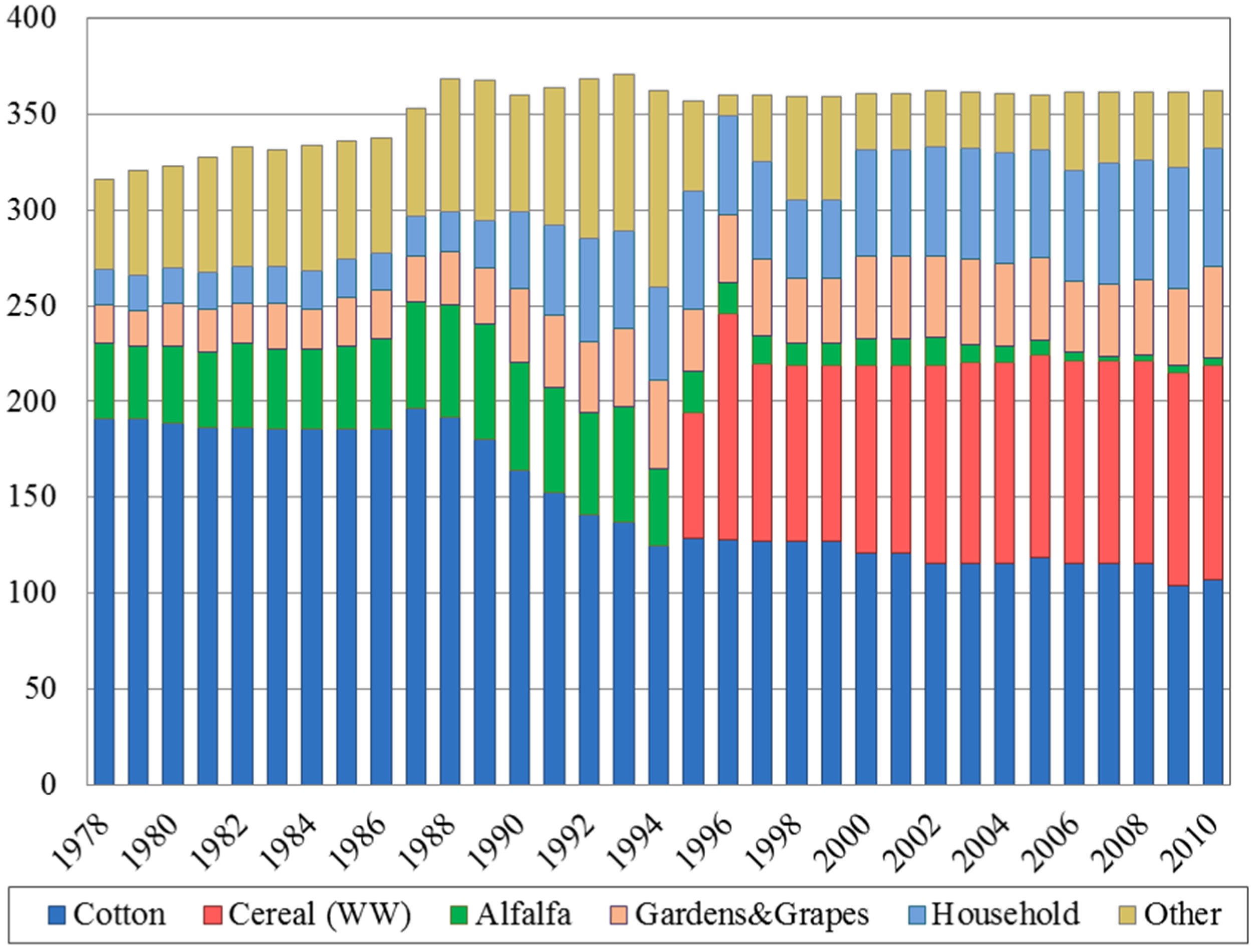
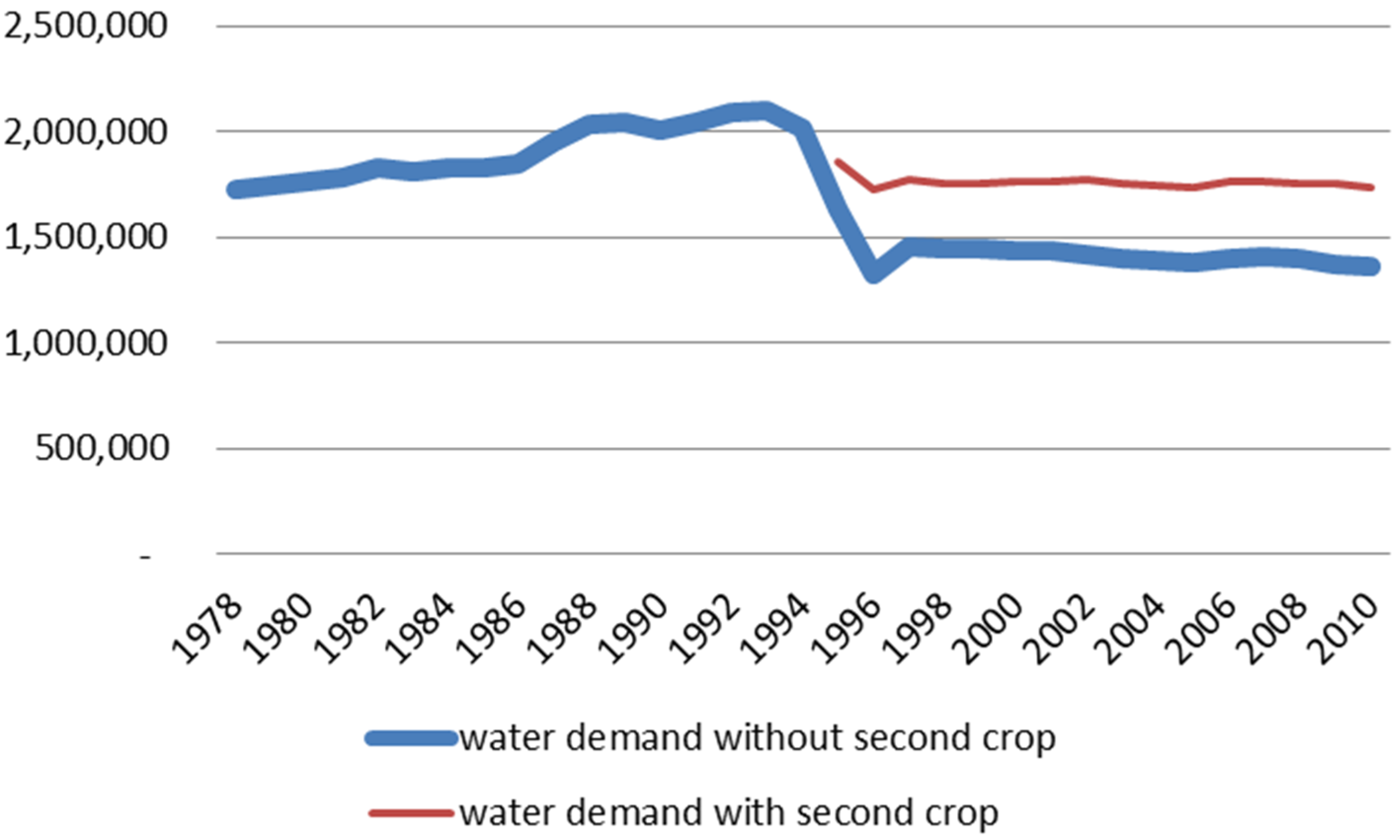
5.4. Current Water Security Approaches Focusing on the Supply Side
5.5. Supply Side Changes—The Irrigation Bureaucracy
5.6. Case Study the Ferghana Province Irrigation Department
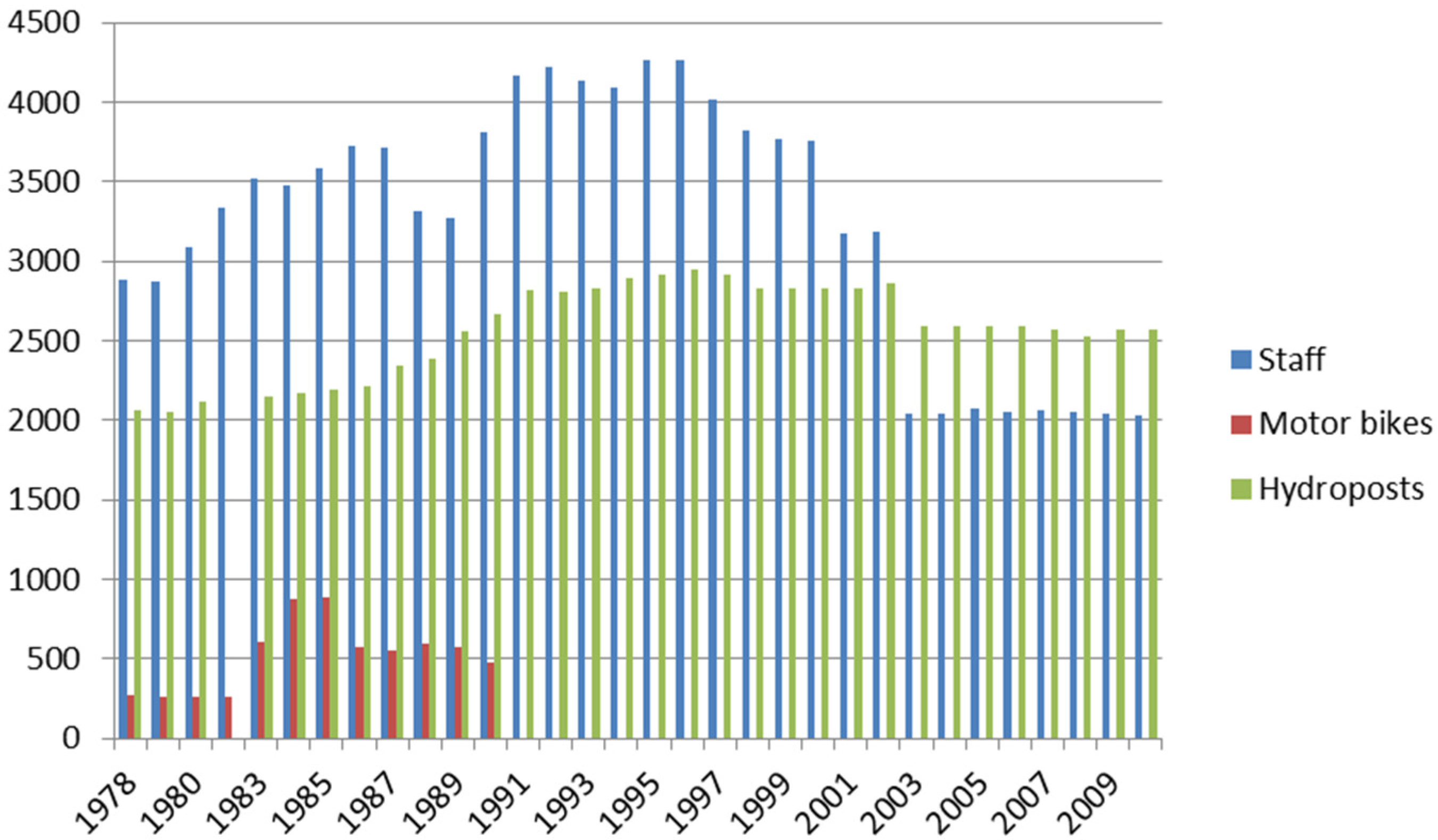

5.7. Short Discussion: Losing Direct Water Security
6. Discussion Linking Irrigation District to Meso-Level Water Security
7. Conclusions
Acknowledgments
Author Contributions
Conflicts of Interest
References
- Wolf, A. Conflict and cooperation along international waterways. Water Policy 1998, 1, 251–265. [Google Scholar] [CrossRef]
- Deininger, R.A.; Meier, P.G. Sabotage of public water supply systems. In Security of Public Water Supplies; Deininger, R.A., Literathy, P., Bartram, J., Eds.; Springer: Berlin, Germany, 2000; pp. 241–248. [Google Scholar]
- Gleick, P.H. Water and terrorism. Water Policy 2006, 8, 481–503. [Google Scholar] [CrossRef]
- United Nations University. Water Security and the Global Water Agenda, a UN-Water Analytical Brief; United Nations University: Hamilton, PA, USA, 2013. [Google Scholar]
- Grey, D.; Sadoff, C. Sink or swim? Water security for growth and development. Water Policy 2007, 9, 545–571. [Google Scholar] [CrossRef]
- Hoff, H. Understanding the Nexus. In Proceedings of the Bonn Conference: The Water, Energy and Food Security Nexus, Stockholm, Sweden, 16–18 November 2011.
- Faures, J.M.; Svendson, M.; Turral, H. Water for Food, Water for Life: A Comprehensive Assessment of Water Management in Agriculture; Earthscan: London, UK, 2007; pp. 353–394. [Google Scholar]
- Tortajada, C.; Biswas, A.K. Editorial: Infrastructure and development. Int. J. Water Resour. Dev. 2014, 30, 3–7. [Google Scholar] [CrossRef]
- Lankford, B.; Hepworth, N. The cathedral and the bazaar: Monocentric and polycentric river basin management. Water Altern. 2010, 3, 82–101. [Google Scholar]
- Lautze, J.; Wegerich, K.; Kazbekov, J.; Yakubov, M. International river basin organizations: Variation, options and insights. Water Int. 2013, 38, 30–42. [Google Scholar] [CrossRef]
- Wescoat, J.L.; Halvorson, S.J.; Mustafa, D. Water management in the Indus basin of Pakistan: A halfcentury perspective. Int. J. Water Resour. Dev. 2000, 16, 391–406. [Google Scholar] [CrossRef]
- Stucki, V.; Sojamo, S. Nouns and numbers of the water-energy-security nexus in central Asia. Int. J. Water Resour. Dev. 2012, 28, 399–418. [Google Scholar] [CrossRef]
- Granit, J.; Jägerskog, A.; Lindström, A.; Björklund, G.; Bullock, A.; Löfgren, R.; de Gooijer, G.; Pettigrew, S. Regional options for addressing the water, energy and food nexus in central Asia and the Aral sea basin. Int. J. Water Resour. Dev. 2012, 28, 419–432. [Google Scholar] [CrossRef]
- Wegerich, K.; Kazbekov, J.; Kabilov, F.; Mukhamedova, N. Meso-level cooperation on transboundary tributaries and infrastructure in the Ferghana Valley. Int. J. Water Resour. Dev. 2012, 28, 525–543. [Google Scholar] [CrossRef]
- Pak, M.; Wegerich, K.; Kazbekov, J. Re-examining conflict and cooperation in central Asia: A case study from the Isfara river, Ferghana Valley. Int. J. Water Resour. Dev. 2014, 30, 230–245. [Google Scholar] [CrossRef]
- Pak, M.; Wegerich, K. Competition and benefit sharing in the Ferghana Valley: Soviet negotiations on transboundary small reservoir construction. Cent. Asian Aff. 2014, 1, 225–246. [Google Scholar] [CrossRef]
- Soliev, I.; Wegerich, K.; Kazbekov, J. The costs of benefit sharing: Historical and institutional analysis of shared water development in the case of the Ferghana Valley in the Syr Darya basin. Water 2015, 7, 2728–2752. [Google Scholar] [CrossRef]
- Ertsen, M.W. Colonial irrigation: Myths of emptiness. Landsc. Res. 2006, 31, 147–167. [Google Scholar] [CrossRef]
- Ertsen, M.W. The development of irrigation design schools or how history structures human action. Irrig. Drain. 2007, 56, 1–19. [Google Scholar] [CrossRef]
- Vermillion, D.L. Impacts of Irrigation Management Transfer: A Review of the Evidence. Available online: http://www.iwmi.cgiar.org/Publications/IWMI_Research_Reports/PDF/pub011/REPORT11.PDF (accessed on 7 February 2007).
- Water Sector Policy Review and Strategy Formulation: A General Framework. Available online: http://www.fao.org/docrep/v7890e/v7890e00.htm (accessed on 9 February 2007).
- Irrigation Management Transfer: Worldwide Efforts and Results. Available online: http://www.fao.org/3/a-a1520e.pdf (accessed on 21 April 2014).
- Irrigation Reform in Asia: A review of 108 Cases of Irrigation Management Transfer. Available online: https://ideas.repec.org/p/iwt/rerpts/h042851.html (accessed on 20 April 2014).
- Wegerich, K.; Warner, J.; Tortajada, C. Water sector governance: A return ticket to anarchy. Int. J. Water Gov. 2014, 2, 7–20. [Google Scholar] [CrossRef]
- Rap, E.; Wester, P. The practices and politics of making policy: Irrigation management transfer in Mexico. Water Altern. 2013, 6, 506–531. [Google Scholar]
- Surhardiman, D.; Giordano, M. Is there an alternative for irrigation reform? World Dev. 2014, 57, 91–100. [Google Scholar] [CrossRef]
- Molle, F.; Mollinga, P.P.; Wester, P. Hydraulic bureaucracies and the hydraulic mission: Flows of water, flows of power. Water Altern. 2009, 2, 328–349. [Google Scholar]
- Spoor, M.; Krutov, A. XI. The power of water in a divided central Asia. Perspect. Glob. Dev. Technol. 2003, 2, 593–614. [Google Scholar] [CrossRef]
- Abdullaev, I.; de Fraiture, C.; Giordano, M.; Yakubov, M.; Rasulov, A. Agricultural water use and trade in Uzbekistan: Situation and potential impacts of market liberalization. Int. J. Water Resour. Dev. 2009, 25, 47–63. [Google Scholar] [CrossRef]
- Hirsch, D. Water User Associations in Uzbekistan: Theory and Practice. Ph.D. Thesis, University of Bonn, Cuvillier Verlag, Göttingen, Germany, June 2006. [Google Scholar]
- Abdullaev, I.; Kazbekov, J.; Manthritilake, H.; Jumaboev, K. Water user groups in central Asia: Emerging form of collective action in irrigation water management. Water Resour. Manag. 2009, 24, 1029–1043. [Google Scholar] [CrossRef]
- Abdullaev, I.; Kazbekov, J.; Manthritilake, H.; Jumaboev, K. Participatory water management at the main canal: A case from South Ferghana canal in Uzbekistan. Agric. Water Manag. 2009, 96, 317–329. [Google Scholar] [CrossRef]
- Abdullaev, I.; Kazbekov, J.; Jumaboev, K.; Manthritilake, H. Adoption of integrated water resources management principles and its impacts: Lessons from Ferghana Valley. Water Int. 2009, 34, 230–241. [Google Scholar] [CrossRef]
- Nexus Nirvana or Nexus Nullity? A Dynamic Approach to Security and Sustainability in the Water-Energy-Food Nexus. Available online: http://steps-centre.org/wp-content/uploads/Water-and-the-Nexus.pdf (accessed on 30 April 2015).
- Critical Infrastructure Partnership Advisory Council Water Sector Strategic Planning Working Group. Available online: https://www.gov.uk/government/uploads/system/uploads/attachment_data/file/170644/28307_Cm_8583_v0_20.pdf (accessed on 29 April 2015).
- Contest: The United Kingdom’s Strategy for Countering Terrorism Annual Report. Available online: https://www.gov.uk/government/uploads/system/uploads/attachment_data/file/170644/28307_Cm_8583_v0_20.pdf (accessed on 29 April 2015).
- Lautze, J.; Manthrithilake, H. Water Security. In Key Concepts in Water Resource Management; Lautze, J., Ed.; Routledge: Oxford, UK, 2014. [Google Scholar]
- Sadoff, C.W.; Hall, J.W.; Grey, D.; Aerts, J.C.J.H.; Ait-Kadi, M.; Brown, C.; Cox, A.; Dadson, S.; Garrick, D.; Kelman, J.; et al. Securing Water, Sustaining Growth: Report of the GWP/OECD Task Force on Water Security and Sustainable Growth; University of Oxford: Oxford, UK, 2015. [Google Scholar]
- Saldías, C.; Boelens, R.; Wegerich, K.; Speelman, S. Losing the watershed focus: A look at complex community-managed irrigation systems in Bolivia. Water Int. 2012, 37, 744–759. [Google Scholar] [CrossRef]
- Dill, B.; Crow, B. The colonial roots of inequality: Access to water in urban East Africa. Water Int. 2014, 39, 187–200. [Google Scholar] [CrossRef]
- Boelens, R.; Seemann, M. Forced engagements: Water security and local rights formalization in Yanque, Colca Valley, Peru. Hum. Organ. 2014, 73, 1–11. [Google Scholar] [CrossRef]
- Boelens, R. The Shotgun Marriage: Water Security, Cultural Politics, and Forced Engagements between Official and Local Rights Frameworks; Routledge: Oxford, UK, 2013. [Google Scholar]
- Tortajada, C. Water management for a megacity: Mexico City metropolitan area. AMBIO J. Hum. Environ. 2003, 32, 124–129. [Google Scholar] [CrossRef]
- Molle, F.; Berkoff, J. Cities Versus Agriculture: Revisiting Intersectoral Water Transfers, Potential Gains and Conflicts; International Water Management Institute: Colombo, Sri Lanka, 2006. [Google Scholar]
- Mukhamedova, N.; Wegerich, K. Integration of villages into WUAS—The rising challenge for local Water management in Uzbekistan. Int. J. Water Gov. 2014, 2, 153–179. [Google Scholar] [CrossRef]
- Earle, A. The role of cities as drivers of international transboundary water management processes. In Water Security: Principles, Perspectives and Practices; Routledge: Oxford, UK, 2013. [Google Scholar]
- Allan, T.; Keulertz, M.; Woertz, E. The water-food-energy nexus: An introduction to nexus concepts and some conceptual and operational problems. Int. J. Water Resour. Dev. 2015, 31, 301–311. [Google Scholar] [CrossRef]
- Keulertz, M.; Woertz, E. Financial challenges of the nexus: Pathways for investment in water, energy and agriculture in the Arab world. Int. J. Water Resour. Dev. 2015, 31, 312–325. [Google Scholar] [CrossRef]
- Boelens, R.; Doornbos, B. The battlefield of water rights. rule making amidst conflicting normative frameworks in the ecuadorian highlands. Hum. Organ. 2001, 60, 343–355. [Google Scholar] [CrossRef]
- Swyngedouw, E. Dispossessing H2O: The contested terrain of water privatization. Capital. Nat. Soc. 2005, 16, 81–98. [Google Scholar] [CrossRef]
- Wegerich, K. The Afghan water law: “A legal solution foreign to reality”? Water Int. 2010, 35, 298–312. [Google Scholar] [CrossRef]
- Dimitrov, R.S. Water, conflict and security: A conceptual minefield. Soc. Nat. Resour. 2002, 15, 677–691. [Google Scholar] [CrossRef]
- Zeitoun, M. The web of sustainable water security. In Water Security: Principles, Perspectives and Practices; Routledge: Oxford, UK, 2014. [Google Scholar]
- Gleick, P.H. The changing water paradigm: A look at twenty-first century water resource development. Water Int. 2000, 25, 127–138. [Google Scholar] [CrossRef]
- Lankford, B. Infrastructure hydromentalities: Water sharing, water control and water (in) security in Lankford. In Water Security: Principles, Perspectives and Practices; Routledge: Oxford, UK, 2014; pp. 256–272. [Google Scholar]
- Molden, D.J.; Vaidya, R.A.; Shrestha, A.B.; Rasul, G.; Shrestha, M.S. Water infrastructure for the Hindu Kush Himalayas. Int. J Water Resour. Dev. 2014, 30, 60–77. [Google Scholar] [CrossRef]
- Biswas-Tortajada, A. The Gujarat state-wide water supply grid: A step towards water security. Int. J. Water Resour. Dev. 2014, 30, 78–90. [Google Scholar] [CrossRef]
- Bottrall, A.F. Comparative Study of the Management and Organization of Irrigation Projects. Available online: http://documents.worldbank.org/curated/en/1981/05/438966/comparative-study-management-organization-irrigation-projects (accessed on 25 April 2015).
- Chambers, R. Managing Canal Irrigation; Oxford & IBH Publishing: New Delhi, India, 1988. [Google Scholar]
- Uphoff, N.T. Managing Irrigation: Analyzing and Improving the Performance of Bureaucracies; Sage publication: Thousand Oaks, CA, USA, 1991. [Google Scholar]
- Uphoff, N.T. Improving International Irrigation Management with Farmer Participation: Getting the Process Right; Westview Press: Boulder, CO, USA, 1986. [Google Scholar]
- Mollinga, P.P. On the Water Front; Orient Longman: New Delhi, India, 2003. [Google Scholar]
- Ali, I. The Punjab under Imperialism 1885–1947; Princeton University Press: Princeton, NJ, USA, 1988. [Google Scholar]
- Bolding, A.; Mollinga, P.P.; van Straaten, K. Modules for modernization: Colonial irrigation in India and the technological dimension of agrarian change. J. Dev. Stud. 1995, 31, 805–844. [Google Scholar] [CrossRef]
- Ul-Haq, A. Case Study of the Punjab Irrigation Department; International Water Management Institute: Colombo, Sri Lanka, 1998. [Google Scholar]
- Wade, R. Irrigation reform in the conditions of populist anarchy: An Indian case. J. Dev. Econ. 1984, 14, 285–303. [Google Scholar] [CrossRef]
- Deininger, R.A.; Literathy, P.; Bartram, J. Security of Public Water Supplies; Springer: Berlin, Germany, 2000. [Google Scholar]
- Davis, J.; Whittington, D. Challenges for water sector reform in transition economies. Water Policy 2004, 6, 381–395. [Google Scholar]
- Managing Singapore’s Water. Available online: http://www.businesstimes.com.sg/opinion/managing-singapores-water (accessed on 24 April 2015).
- Wegerich, K. Shifting to hydrological/hydrographic boundaries: A comparative assessment of national policy implementation in the Zerafshan and Ferghana Valleys. Int. J. Water Resour. Dev. 2015, 31, 88–105. [Google Scholar] [CrossRef]
- Bakker, K. Archipelagos and networks: Urbanization and water privatization in the South. Geogr. J. 2003, 169, 328–341. [Google Scholar] [CrossRef]
- Shah, T. Taming the Anarchy: Groundwater Governance in South Asia; Routledge: Oxford, UK, 2010. [Google Scholar]
- Molle, F.; Wester, P.; Hirsch, P. River basin closure: Processes, implications and responses. Agric. Water Manag. 2010, 97, 569–577. [Google Scholar] [CrossRef]
- Saiko, T.A.; Zonn, I.S. Irrigation expansion and dynamics of desertification in the Circum-Aral region of Central Asia. Appl. Geogr. 2000, 20, 349–367. [Google Scholar] [CrossRef]
- Zonn, I.S.; Glantz, M.; Kosarev, A.N.; Kostianoy, A.G. The Aral Sea Encyclopedia; Springer: Berlin, Germany, 2009. [Google Scholar]
- Kasymova, V. National Constraining Factors to the Agreement on Water and Energy Use in the Syr Darya Basin. Available online: http://rmportal.net/library/content/tools/environmental-policy-and-institutional-strengthening-epiq-iqc/epiq-environmental-policy-and-institutional-strengthening-cd-vol-1/epiq-cd-1-tech-area-dissemination-of-policy-knowledge-environmental-communication/national-constraining-factors-to-the-agreement-on-water-and-energy-use-in-the-syr-darya-basin-the-tajik-republic/view (accessed on 30 January 2015).
- Weinthal, E. Sins of omission: Constructing negotiating sets in the Aral Sea basin. J. Environ. Dev. 2001, 10, 50–79. [Google Scholar]
- The World Bank. Water Energy Nexus in Central Asia: Improving Regional Cooperation in the Syr Darya Basin, Europe and Central Asia Region; The World Bank: Washington, DC, USA, 2004. [Google Scholar]
- Ryabtsev, A.D. Threats to Water Security in the Republic of Kazakhstan in the Transboundary Context and Possible ways to Eliminate them. 2008. Available online: http://www.icwc-aral.uz/workshop_march08/pdf/ryabtsev_en.pdf (accessed on 7 February 2009).
- Libert, B.; Orolbaev, E.; Steklov, Y. Water and energy crisis in central Asia. China Eurasia Forum Q. 2008, 6, 9–20. [Google Scholar]
- Antipova, E.; Zyryanov, A.; McKinney, D.; Savitsky, A. Optimization of Syr Darya water and energy uses. Water Int. 2002, 27, 504–516. [Google Scholar] [CrossRef]
- McKinney, D.; Kenshimov, A.K. Optimization of the Use of Water and Energy Resources in the Syr Darya Basin under Current Conditions. Available online: http://www.caee.utexas.edu/prof/mckinney/papers/aral/00-06-W/00-06-W_eng/Vol-1/Front1e.htm (accessed on 24 April 2015).
- Wegerich, K.; Kazbekov, J.; Lautze, J.; Platonov, A.; Yakubov, M. From monocentric ideal to polycentric pragmatism in the Syr Darya: Searching for second best approaches. Int. J. Sustain. Soc. 2012, 4, 113–130. [Google Scholar] [CrossRef]
- Pak, M. International River Basin Management in the Face of Change: Syr Darya Basin Case Study. Ph.D. Thesis, Oregon State University, Corvallis, OR, USA, November 2014. [Google Scholar]
- Strengthening Cooperation for Rational and Efficient Use of Water and Energy Resources in Central Asia. Available online: http://www.unece.org/fileadmin/DAM/env/water/damsafety/effuse_en.pdf (accessed on 10 May 2010).
- Wegerich, K. Have your cake and eat it too: Agenda setting in central Asian transboundary rivers. In Water, Environmental Security and Sustainable Rural Development: Conflict and Cooperation in Central Eurasia; Arsel, M., Spoor, M., Eds.; Routledge: Oxford, UK, 2010. [Google Scholar]
- Dukhovny, V.А.; Sorokin, А.G.; Тuchin, А.I.; Sorokin, D.A.; Теmlyantseva, Y. Concept of Integrated Model for Chirchik-Ahangaran-Keles Sub-Basin. Available online: http://cawater-info.net/rivertwin/documents/pdf/concept6_e.pdf (accessed on 30 March 2015).
- Dukhovny, V.A.; Sorokin, A.G.; Tuchin, A.I.; Rysbekov, U.H.; Stulina, G.V.; Nerosin, S.A.; Rusiev, I.B.; Sorokin, D.A.; Katz, A.; Shahov, V.; Solodky, G. A regional model for integrated water management in twinned river basins. Available online: http://s3.amazonaws.com/zanran_storage/www.rivertwin.de/ContentPages/2493962769.pdf (accessed on 30 March 2015).
- Rysbekov, Y.K. Rivertwin Central Asia: The basic Results of Work Package 7. Available online: http://www.cawater-info.net/rivertwin/documents/pdf/rysbekov2_presentation_e.pdf (accessed on 30 March 2015).
- Benjaminovich, Z.M.; Tersitskiy, D.K. Irrigation of Uzbekistan II; Fan Publishing House: Tashkent, Uzbekistan, 1975. (In Russian) [Google Scholar]
- Weinthal, E. State Making and Environmental Cooperation; The MIT Press: Cambridge, MA, USA, 2002. [Google Scholar]
- Wegerich, K.; Kazbekov, J.; Mukhamedova, N.; Musayev, S. Is it possible to shift to hydrological boundaries? The ferghana valley meshed system. Int. J. Water Resour. Dev. 2012, 28, 545–564. [Google Scholar] [CrossRef]
- Wegerich, K.; Soliev, I.; Akramova, I. Estimation of the long term costs to cope with upstream irrigation expansion in the transboundary setting of Ferghana Province. Int. J. Water Gov. 2015. submitted for publication. [Google Scholar]
- Dukhovny, V.A. Water and globalization: Case study of Central Asia. Irrig. Drain. 2007, 56, 489–507. [Google Scholar] [CrossRef]
- Central Asia: Water and conflict. Available online: http://www.crisisgroup.org/en/regions/asia/central-asia/034-central-asia-water-and-conflict.aspx (accessed on 9 December 2014).
- Ferghana Province Irrigation Department. Annual Reports 1978–2010; Ferghana Province Irrigation Department: Ferghana, Uzbekistan, 2011. [Google Scholar]
- Bucknall, J.; Klytchnikova, I.; Lampietti, J.; Lundell, M.; Scatasta, M.; Thurman, M. Irrigation in Central Asia: Social, Economic and Environmental Considerations. Available online: http://siteresources.worldbank.org/ECAEXT/Resources/publications/Irrigation-in-Central-Asia/Irrigation_in_Central_Asia-Full_Document-English.pdf (accessed on 5 October 2014).
- Law of the Republic of Uzbekistan. In On Dehkan Farms; No. 654-XII; The Senate of the Republic of Uzbekistan: Tashkent, Uzbekistan, 1992. (In Uzbekistan)
- Law of the Republic of Uzbekistan. In On Farms; No. 599-I; The Senate of the Republic of Uzbekistan: Tashkent, Uzbekistan, 1998. (In Uzbekistan)
- Orders of Cabinet of Ministers and Presidential Decree. In On Measures to Further Optimize the Size of Land Plots of Farms; No. F-3287 and F-3212; The Senate of the Republic of Uzbekistan: Tashkent, Uzbekistan, 2009. (In Uzbekistan)
- Dukhovny, V.A.; de Schuetter, J.L.G. Water in Central Asia: Past, Present, Future; CRC Press: Boca Raton, MA, USA, 2011. [Google Scholar]
- Anderson, J. The International Politics of Central Asia; Manchaster University Press: Manchaster, UK, 1997. [Google Scholar]
- Pomfret, R. Agrarian reform in Uzbekistan: Why has the Chinese model failed to deliver? Econ. Dev. Cult. Chang. 2002, 48, 269–282. [Google Scholar] [CrossRef]
- Djanibekov, N.; Rudenko, I.; Lamers, J.P.A.; Bobojonov, I. Pros and cons of cotton production in Uzbekistan, case study of the program: “Food policy for development countries: The role of government in the global food system. 2010. Available online: http://chatt.hdsb.ca/~blairj/course_files/FOV1-001625C2/cotton%20case%20study.pdf (accessed on 14 January 2014).
- Platonov, A.; Wegerich, K.; Kazbekov, J.; Kabilov, F. Beyond the state order? Second crop production in the Ferghana Valley, Uzbekistan. Int. J. Water Gov. 2014, 2, 83–104. [Google Scholar] [CrossRef]
- Resolution of the Cabinet of Ministers Republic of Uzbekistan. In On Measures for the Reorganization of Agricultural Enterprises into Farms; No. 8; Cabinet of Ministers Republic of Uzbekistan: Tashkent, Uzbekistan, 2002. (In Uzbekistan)
- Swiss Agency for Development and Cooperation (SDC). Regional Water Sector Programme Central Asia—Water Management Backstopping (Irrigation); Swiss Agency for Development and Cooperation: Bern, Switzerland, 2008. [Google Scholar]
- Abdullaev, I.; Rakhmatullaev, S.; Platonov, A.; Sorokin, D. Improving water governance in central Asia through application of data management tools. Int. J. Environ. Stud. 2012, 69, 151–168. [Google Scholar] [CrossRef]
- Thurman, M. Irrigation and Poverty in Central Asia: A Field Assessment; World Bank Group: Washington, DC, USA, 2001. [Google Scholar]
- Wegerich, K. Organizational problems of water distribution in Khorezm, Uzbekistan. Water Int. 2004, 29, 130–137. [Google Scholar] [CrossRef]
- Wegerich, K. What happens in a merger? Experiences of the state department for water resources in Khorezm, Uzbekistan. Phys. Chem. Earth 2005, 30, 455–462. [Google Scholar] [CrossRef]
- Yalcin, R.; Mollinga, P.P. Institutional Transformation in Uzbekistanʼs Agricultural and Water Resources Administration: The Creation of a New Bureaucracy. Available online: http://www.econstor.eu/dspace/handle/10419/88374 (accessed on 11 June 2008).
- Djalalov, A.A.; Mirzaev, N.N.; Horst, M.G.; Stulina, G.V.; Abdurazakov, Z.B.; Ergashev, O.; Khoshimov, A.; Rasulov, F.; Alesandrova, N.G. Comprehensive Hydrographic Study of the Ferghana Valley: Vision of the Integrated Water Resources Management based on the IWRM-FV Project Experience in Uzbekistan; Scientific Information Centre of the Interstate Commission on Water Coordination: Tashkent, Uzbekistan, 2011. [Google Scholar]
- Dukhovny, V.A.; Sokolov, V.I.; Galustyan, A.; Djalalov, A.A.; Mirzaev, N.N.; Horst, M.G.; Stulina, G.V.; Muminov, S.; Ergashev, I.; Kholikov, A.; et al. Report on Comprehensive Hydrographic Study of the Ferghana Valley; Scientific Information Centre of the Interstate Commission on Water Coordination: Tashkent, Uzbekistan, 2012. [Google Scholar]
- Suhardiman, D.; Giordano, M.; Rap, E.; Wegerich, K. Bureaucratic reform in irrigation: A review of four case studies. Water Altern. 2014, 7, 442–463. [Google Scholar]
- Bichsel, C. Conflict Transformation in Central Asia: Irrigation Disputes in the Ferghana Valley; Routledge: Oxford, UK, 2009. [Google Scholar]
- Inagamov, S.R. The Uzbek model, the Sunday Indian. Available online: http://www.thesundayindian.com/en/story/the-uzbek-model/7/26310/ (accessed on 5 July 2014).
- Peyrouse, S. The Russian Minority in Central Asia: Migration, Politics, and Language; Woodrow Wilson International Center for Scholars: Washington, DC, USA, 2008. [Google Scholar]
- Taube, G.; Zettelmeyer, J. Output Decline and Recovery in Uzbekistan: Past Perfarmance and Future Prospects. Available online: https://www.imf.org/external/pubs/cat/longres.aspx?sk=2745.0 (accessed on 14 August 2014).
- Kandiyoti, D. Poverty in transition: An ethnographic critique of household surveys in post-soviet central Asia. Dev. Chang. 1999, 30, 499–524. [Google Scholar] [CrossRef]
- WUA Workshop-Country Summary: Kyrgyz Republic. Available online: http://go.worldbank.org/W02GK2LE70 (accessed on 2 May 2015).
© 2015 by the authors; licensee MDPI, Basel, Switzerland. This article is an open access article distributed under the terms and conditions of the Creative Commons Attribution license (http://creativecommons.org/licenses/by/4.0/).
Share and Cite
Wegerich, K.; Van Rooijen, D.; Soliev, I.; Mukhamedova, N. Water Security in the Syr Darya Basin. Water 2015, 7, 4657-4684. https://doi.org/10.3390/w7094657
Wegerich K, Van Rooijen D, Soliev I, Mukhamedova N. Water Security in the Syr Darya Basin. Water. 2015; 7(9):4657-4684. https://doi.org/10.3390/w7094657
Chicago/Turabian StyleWegerich, Kai, Daniel Van Rooijen, Ilkhom Soliev, and Nozilakhon Mukhamedova. 2015. "Water Security in the Syr Darya Basin" Water 7, no. 9: 4657-4684. https://doi.org/10.3390/w7094657






